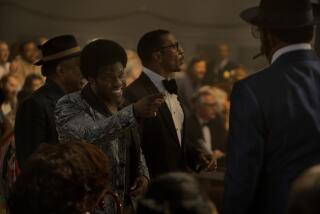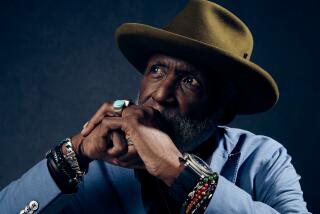‘Brother’ Has Great Fun With ‘Shaft’ Genre
- Share via
The Brooklyn Museum might want to consider pulling some of the space it is taking up with “Star Wars” gear and reallocating it to a mustard-colored Cadillac Coupe de Ville that spins like a woozy top when you hit the brakes. If you want to see the real pop-culture design statement of the ‘70s, look no further. This is the dream machine of “Undercover Brother,” a super soul man who wears a matching, two-toned mustard-colored leather jacket and chugs a complementarily tinted soft drink.
God knows what’s in that soda, but it is having such a euphoric effect on the drinker and his audience, it couldn’t possibly be legal.
Adapted by John Ridley and Michael McCullers from Ridley’s Internet film series, “Undercover Brother” is a funkadelic fun ride that shrewdly reinvigorates the eye-popping styles and pulpy veneer of ‘70s blaxploitation flicks. Unlike the “Scary Movie” films, whose stop-at-nothing jokes were an end unto themselves, this is broad movie spoofing with a point: using the racial divisions and stereotypes manipulated by the “Shaft”-”Super Fly” genre to show how whites came around over the intervening decades to embracing their inner blackness. And how ambivalently many blacks feel about that in return.
The jubilantly upbeat Eddie Griffin sports a panoramic Afro and pork chop sideburns as the Undercover Brother, a crime fighter whose flair for disguise is in keeping with his taste for in-your-face clothes. (He surfaces incognito at a conservative country club golf course dressed as a rainbow-colored Rastafarian.) He is recruited by an African American justice organization known as the B.R.O.T.H.E.R.H.O.O.D. to fight alongside the sultry Sistah Girl (Aunjanue Ellis, in the Cleopatra Jones part). Their target is an evil cell run by the Man, a shadowy white bureaucrat credited with a decline of black cultural identity that reached its nadir with Dennis Rodman.
The Rodman reference signals the take-no-prisoners esprit of a film that rides roughshod over contemporary black role models ranging from Colin Powell (Billy Dee Williams, as a general who throws in his presidency bid to open a fried chicken chain) to Al Roker (a portly and bespectacled Gary Anthony Ramsay, as Smart Brother). The film’s most inspired character is Conspiracy Brother (Dave Chappelle, a textbook in comic timing), a pull-string puppet of angry young black man paranoia.
The object of Conspiracy Brother’s knee-jerk contempt is embodied in the Man’s aide-de-camp, the fey Mr. Feather (Chris Kattan, riffing on gay villains of ‘70s cinema infamy) and the voluptuous White She Devil (Denise Richards). The inevitable shower-wrestling scene between Sistah Girl and White She Devil represents “Undercover Brother” at its glibbest, but the cast is having such a ball (is this the hippest comedy ensemble since “Young Frankenstein” or what?) and director Malcolm D. Lee (of the elegant “The Best Man”) keeps it all moving so breathlessly, you don’t have time to fine-tune your PC radar.
MPAA rating: PG-13, for language, sexual humor, drug content and campy violence. Times guidelines: Even if there were a reason to keep your teens away (there’s not), you probably couldn’t.
Jan Stuart is a film critic for Newsday, a Tribune company.
‘Undercover Brother’
Eddie Griffin...Undercover Brother
Chris Kattan...Mr. Feather
Denise Richards...White She Devil
Aunjanue Ellis...Sistah Girl
Dave Chappelle...Conspiracy Brother
A Universal Pictures and Imagine Entertainment presentation, released by Universal. Director Malcolm D. Lee. Producers Brian Grazer, Michael Jenkinson, Damon Lee. Executive producers John Ridley, Bill Carraro, Kim Roth. Screenplay by John Ridley and Michael McCullers, story by John Ridley, based on the Internet series by John Ridley. Cinematographer Tom Priestley. Editor William Kerr. Costume designer Danielle Hollowell. Music Stanley Clarke. Production designer William Elliott. Art director Elis Lam. Set decorator Clive Thomasson. Running time: 1 hour, 29 minutes.
In general release.
More to Read
Only good movies
Get the Indie Focus newsletter, Mark Olsen's weekly guide to the world of cinema.
You may occasionally receive promotional content from the Los Angeles Times.








